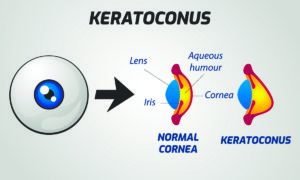Top 5 Keratoconus Questions Answered by Board-Certified Ophthalmologist
- Posted on: May 17 2023
 Keratoconus is a corneal disorder that causes the clear dome of the eye (cornea) to bulge outward and form a cone shape. That abnormal contour distorts vision, causing blurriness and irregular astigmatism that worsens over time. Our board-certified ophthalmologist at Pamel Vision & Laser Group offers various keratoconus treatments. Dr. Gregory Pamel often hears the following questions during consultations at our offices in Astoria and New York, New York.
Keratoconus is a corneal disorder that causes the clear dome of the eye (cornea) to bulge outward and form a cone shape. That abnormal contour distorts vision, causing blurriness and irregular astigmatism that worsens over time. Our board-certified ophthalmologist at Pamel Vision & Laser Group offers various keratoconus treatments. Dr. Gregory Pamel often hears the following questions during consultations at our offices in Astoria and New York, New York.
1. Who Gets Keratoconus?
This condition affects an estimated one in 2,000 people and often impacts one eye more than the other. Men and women of all ethnicities are equally likely to develop keratoconus, which tends to happen around puberty. The cause of keratoconus remains unknown, but researchers believe some people are predisposed to the disease from birth.
While anyone can get keratoconus, there are some risk factors that may increase your likelihood, including:
- Family history of keratoconus
- Chronic eye inflammation caused by allergies or environmental irritants
- Chronic eye rubbing
- Age (Keratoconus is typically discovered during the teenage years, though mild cases may go unnoticed until later in life.)
2. How Does Keratoconus Affect Vision?
The cornea contains collagen fibers that help maintain its round shape. A healthy cornea focuses light rays onto the light-sensitive retina lining the back of the eye, allowing for clear vision. When collagen decreases, the cornea thins and bulges out, scattering light rays. The cornea can no longer refract light correctly onto the retina, causing blurriness, double vision, halos, glare, and light sensitivity. The once smooth surface bulges outward and becomes wavy. Corneal collagen cross-linking is a keratoconus treatment that strengthens collagen fibers for a more stable cornea that holds its shape.
3. Will Keratoconus Cause Blindness?
Keratoconus does not cause blindness, but eyesight gets progressively worse for many years. Blurriness and other visual symptoms are highly treatable with specialty contact lenses and, in severe cases, a corneal transplant. Corneal cross-linking may slow the disease and reduce the risk of needing a transplant.
4. Can Keratoconus Cause Headaches?
Yes, keratoconus may cause headaches and eye pain. The light sensitivity, dry eyes, decreased night vision, and eye strain combined with poor vision increase the incidence of headaches. That head pain may affect your daily life, especially if you’re prone to migraines. People with keratoconus have evolving prescriptions, and frequent vision changes often lead to headaches.
5. When Does Keratoconus Stop Progressing?
Cornea abnormalities caused by keratoconus are typically diagnosed during the teenage years, and keratoconus tends to progress for about 20 years. Many patients experience vision changes into their early 30s and 40s before the disease stabilizes.
Keratoconus treatment requires regular monitoring with a board-certified ophthalmologist. If you struggle with keratoconus, schedule an appointment with Dr. Pamel in Astoria and New York, New York. Contact Pamel Vision & Laser Group at (212) 355-2215.
Posted in: Keratoconus




